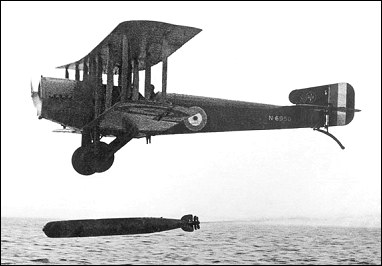| Grant Newman, e-mail, 10.11.2009 10:16 A few comments on the Cuckoo.
It was the first true aircraft carrier (as opposed to seaplane tenders) based torpedoplane and one of the first, if not the first aeroplane type to be specifically designed for operations from flat top aircraft carrier decks. Erronously mentioned in the text - the T.1 did not go to sea aboard Argus in October 1918; the first aircraft carrier based torpedo squadron, No.185 Sqn was formed at East Fortune on 7 October 1918, but was (dubiously) declared ready for ops from Argus later that month, although they did not embark aboard ship at that early stage. This doesn't mean that the aircraft went to sea aboard the carrier, since the first recorded landing of a Cuckoo aboard Argus wasn't until June 1919. 'Ready for operations' was a relative term, since at that time there was no effective means of bringing an aircraft to a stop on a carrier deck - E.H. Dunning in his Pup landing aboard HMS Furious was dragged to a stand still by men clutching at strops under its wings, but clearly this was not ideal. Like the Tondern raid, when seven Camels were launched from Furious' deck to bomb the airship sheds, the Cuckoo pilots, if they had to go to war would have had to ditch their aircraft into the sea. Not the most welcoming nor cost effective means of recovering pilots.
One important point worth mentioning is that the T.1 was designed to a requirement for a torpedoplane that was to be used in an attack against the German High Seas Fleet at its home anchorage at Wilhelmshaven on the Jade River - i.e. a German Pearl Harbour (or 'Copenhagen' for students of naval history) A formal proposal was forwarded to the Admiralty by the Admiral of the Grand Fleet at the time - Adm Sir David Beatty, although it was written by Herbert Richmond, captain of the battleship HMS Conqueror and Sqn Cdr Frederick Rutland. As a result of the proposal, Beatty had some 200 Cuckoos ordered. Due to production difficulties - the Cuckoo was one of a number of aircraft that were not considered a high priority and therefore had production allocated to satellite firms inexperienced in aircraft manufacture - and the very unreliable 200 hp Sunbeam Arab engine (for British aircraft use Imperial measurements, please - 200 hp instead of 149Kw, 18-inch torpedo instead of 450 mm and 90 kts /100 mph instead of 166 kph for heaven's sake), Cuckoos did not reach the fleet airfield's fast enough before the Armistice and the raid, scheduled for mid 1918 never took place, not to mention a lack of suitable vessels to carry the aircraft.
Initially the first contract to build the T.1 was offered to the Fairfield Shipbuilders in Glasgow but because the rate of production was so slow, Blackburn took over their order. The other company to build the T.1 was Pegler and Co brass fitters of Doncaster, their rate of production was not very high either. Blackburn built the most Cuckoos of over 200 built - interestingly enough, Sopwith only built the prototype.
Regarding the type's powerplant, the Arab was chosen off the drawing board and rates as one of the worst engines of the Great War, one other being the ABC Dragonfly - but it was designed to be a copy of the 'Hisso' 200 hp Hispano-suiza V8, which was what, essentially the 200 hp Wolseley Viper was, although the Viper was more reliable and better built than the original 'Hisso'. One example of the Cuckoo III was built, powered by a Rolls Royce Falcon engine, but this was not pursued.
One less well known aspect of the Cuckoo's history is that the type was exported to the Imperial Japanese Navy. In 1921 six Cuckoos and a small naval aviation team was sent to Japan as the British Mission, lead by Colonel the Master of Sempill, to advise the IJN in naval aviation matters. Other aircraft sent include Avro 504Ls on floats, Sopwith Pups, Gloster Sparrowhawks and two Blackburn Swift torpedoplanes. Although the Cuckoos and the Swifts were used only for training, there is no doubt that they made landings aboard Hosho, Japan's first aircraft carrier. Photos survive showing Swifts and Cuckoos carrying out torpedo drops in Tokyo Bay.
To finish off; the aircraft at the head of the page, N6950 was Blackburn built, note the Blackburn logo on the fin, and was the first production Cuckoo to reach the training field, East Fortune in Scotland. The image is most likely taken off the coast of Belhaven Sands, not far from East Fortune, where temporary facilities were set up for operating the torpedo laden aircraft from the beach for torpedo dropping trials and training. reply |





